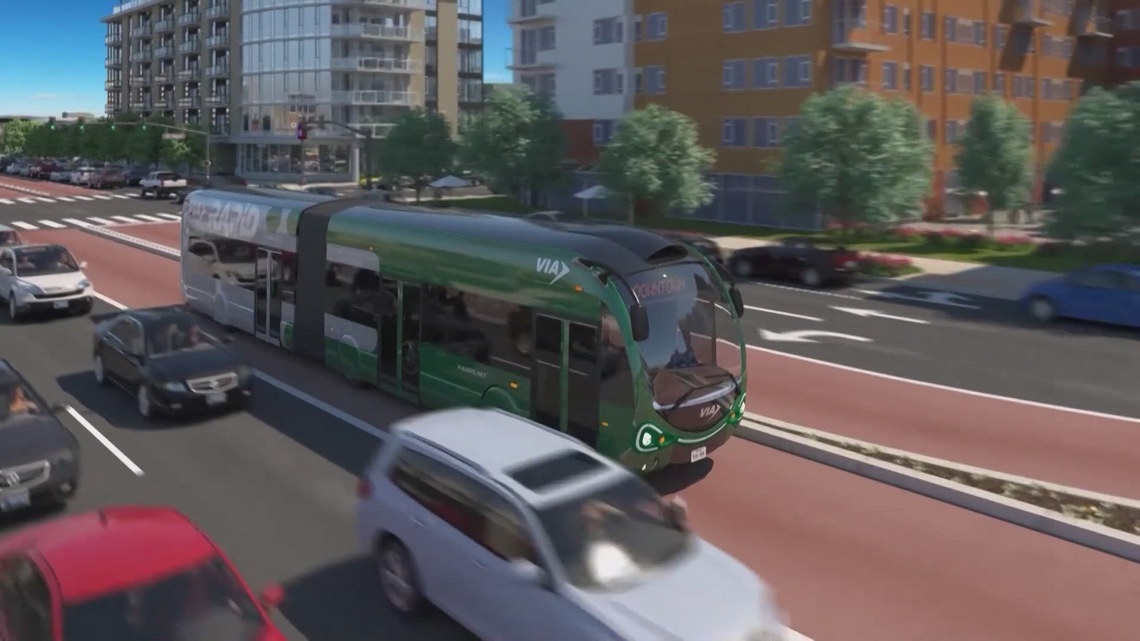
The plan aims to reduce barriers to development, encouraging mixed use housing, businesses and affordable housing to be built around the bus stops.
SAN ANTONIO — A new plan to incentivize development and increase housing around the VIA’s new green advanced rapid transit (art) line was approved by City Council on Thursday.
“It’s about bringing opportunities to make a bus that’s faster and more frequent, because we know that there are two types of users,” said Kat Hernandez, Transportation Director for the city of San Antonio. “One, users that have to utilize transit and those that want to opt into utilizing transit because it’s all about options.”
Transit-oriented development (TOD) aims to reduce barriers to development, encouraging mixed use housing, businesses and affordable housing to be built around the bus stops.
“It’s making sure that we plan appropriately for the right intensity of uses, the right intensity and density,” Hernandez explained. “And make sure that we have, that we create walkable communities along our transit lines.”
But before it was passed, there was significant pushback from residents who live in neighborhoods around the new art line. With concerns of access to alcohol tied to new businesses, and parking availability once TOD is implemented. The majority of them fighting for parking restrictions, or to get rid of the plan entirely, arguing it was too rushed and could cause displacement.
“This under building a parking will cause subsequent parking spillover into surrounding neighborhoods that are not designed to accommodate dense traffic or parking,” said Gemma Kennedy, planning chair for the River Road neighborhood. “The neighbors will be directly feel the impact of this.”
For the Crownhill neighborhood, there’s concern of pedestrian safety.
“We already have significant traffic congestion as well as dangerous traffic situations that directly jeopardize pedestrian safety,” said Kelly Walls.
During council discussion, Councilmember Marina Alderete Gavito of district seven did attempt to amend the policy framework to include parking restrictions.
“After several conversations with stakeholders, neighbors, business leaders, I do believe there is a way to implement TOD that is also respectable to neighborhoods and their parking concerns,” Alderete Gavito said.
Her amendment would’ve allowed affordable housing developments to be exempt from parking requirements, provide more flexible options for parking requirements for properties that are being reused or the property is smaller than 10,000 feet. Different properties within a half-mile could make agreements to share parking spaces, and building a parking garage in mixed zoning districts would require special approval from the city.
While some councilmembers agreed with Alderete Gavito’s amendment, councilwoman Sukh Kaur of District 1, who has been supportive of the policy framework since the beginning, argued parking requirements restrict developers and increase costs.
Adding parking requirements adds cost to total projects, and if projects can’t pencil, they can’t be funded,” Kaur argued. “You have to get a little bit more creative and innovative. That does mean that the developer has to make the decision to do what makes sense for each individual property. So all we’re saying today is that as developments come through, we’re giving the we’re putting the onus on the team that’s developing the land to make a decision about what makes sense for parking in that specific instance.”
Ultimately the Alderete Gavito’s amendment failed 3-7, Councilman John Courage of District 9 was absent.
Councilmember Melissa Cabello Havrda also amended the policy framework to allow for restaurants, taverns, and bars to sell alcohol without having to jump through additional hoops. That did pass.
“We’re mixing alcohol with no parking,” said Patty Gibbons with the Greater Harmony Hills Neighborhood Association. “It is a problem. I’m not happy with those two, when I feel like the residents, the neighborhoods were compromising very well and collaborating very well. But with these two caveats, then it comes to city council , and we lost it there. The collaboration link failed right here.”
While TOD will apply to any new ART lines, boundary lines and specifics will have to be determined for each transit line. Businesses, developers, and anyone who owns a property within the now determined boundary lines on San Pedro, can choose to opt into transit oriented development, though they’ll still have to go through the process to rezone.
Eventually the transportation department states there will be incentives for housing to bring in density, though what those incentives will be is still yet to be determined.
